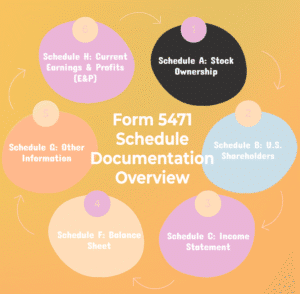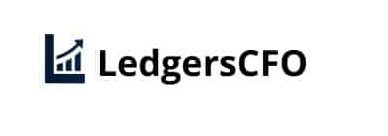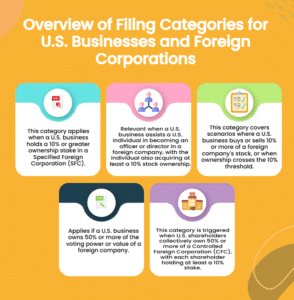A Guide to Filing Form 5471: Categories of Filers Explained
- June 30, 2025
- Posted by: Sarwat Sayyed
- Category: Uncategorized
Form 5471 Filing: Find Out What Type of U.S. Shareholder You Are

Understanding the Filing Categories of Form 5471
When your U.S. business owns or controls shares in a foreign company. Form 5471 serves as the IRS’s mechanism for disclosing your ownership or control in a foreign corporation. The IRS classifies filers into five categories based on ownership type and transactions. Each has unique reporting obligations
It is important to know the right category. Because each one needs different disclosures and plans. If you file under the wrong category, you might miss important information, which leads to fines or extra attention from the IRS.
Overview of Filing Categories (1– 5)
Category 1
This applies to U.S. persons, such as individuals and corporations, who qualify as U.S. shareholders. A U.S. shareholder is any U.S. person holding 10% or more of the vote or value in a Specified Foreign Corporation (SFC), as defined under the Tax Cuts and Jobs Act.
Example:
A U.S. business holds a 25% stake in a foreign manufacturing company. The foreign entity meets the criteria for classification as a specified foreign corporation (SFC). The U.S. corporation is required to file under Category 1.
Category 2
This rule applies to U.S. persons who acquire stock in a foreign corporation and, as a result, cause a U.S. person to become an officer or director
Example:
A U.S. firm obtains a 12% stake in a foreign corporation and appoints a U.S. executive to its board of directors. It should be classified as Category 2.
Category 3
Applies to U.S. persons who acquire (or dispose of) stock resulting in 10% or more ownership or a change of 10% or more.
Example:
A U.S. business increases its ownership in a foreign entity from 8% to 15%. It should be classified as Category 3.
Category 4
This applies to U.S. businesses that own more than 50% of the voting power or value of a foreign corporation.
Example:
A U.S. company possesses a 60% stake in a foreign subsidiary. It should be classified as Category 4.
Category 5
This applies to U.S. shareholders of a Controlled Foreign Corporation (CFC). A CFC is a foreign corporation where U.S. shareholders together own more than 50%, with each holding at least 10%.
Example:
A U.S. firm owns 30% of a foreign company, and other U.S. shareholders own another 30%. The company qualifies as a CFC and must file under Category 5.
Criteria for Determining Filing Obligation:
A person or company in the United States must first check to see if they need to file IRS Form 5471 and, if so, what category they fall into. The IRS decides this based on rules about who owns what, what a company’s job is, and how much control there is.
Here are the most important factors, with easy-to-understand examples:
1. How much ownership there is (direct, indirect, or constructive)
It’s important to check how much stock is held in a foreign company, not just directly but also indirectly or constructively (through family or other companies).
Example:
John, a citizen of the United States, owns 8% of a foreign company directly and another 4% through a trust. Since his total interest is 12%, he has more than 10%, which means he has to file.
Should be filed under Category 3 if it’s a new purchase or Category 5 if the company is a CFC.
2. The buying or selling of stocks
If you buy or sell 10% or more of a foreign company’s stock, you have to file a report. It also applies if the amount of ownership you have goes up or down by more than 10%.
Example:
A U.S. company raises its stake in a foreign company from 9% to 15%. That jump means you have to report it.
This is a Category 3 event, which means it has to do with purchases or changes in ownership.
3. The choice of a U.S. director or officer
A filing requirement is made when a U.S. person or business makes another U.S. person become a director or officer of a foreign firm while also owning 10% or more of the company.
Example:
A U.S. company gets 12% of the stock in a foreign company and puts a U.S. executive on the board of that company.
4. If the foreign company is a CFC or an SFC
Controlled Foreign Corporations (CFCs) are foreign companies that have at least 10% of their shares owned by people in the United States. These people own more than 50% of the company.
A Specified Foreign Corporation (SFC) is any CFC or other foreign company that has at least 10% U.S. business ownership.
Example:
Three American owners own 65% of a foreign company as a whole. Each has more than 10%. People call that business a CFC.
Changes to the filing process: U.S. owners must file under Category 5. Also, if the filer is a U.S. company and the foreign company is an SFC, it may be in Category 1.
Documentation for Each Category:

After a U.S. person figures out what type of Form 5471 it needs to file, the next step is to know which parts of the form need to be sent in. Based on the amount of ownership, control, or activity with the foreign corporation, each schedule asks for different kinds of data.
Schedule A: Stock of the Foreign Corporation:
It is Used to report stock ownership details such as types of stock, number of shares, and changes throughout the year.
Required for: Categories 3, 4, 5
Schedule B: U.S. of Foreign Corporation:
It shows the names and percentages of U.S. citizens who own shares in the foreign company. This is needed whenever there is a change in ownership or control.
Required for: Categories 2, 3, 4, 5
Schedule C: Statement of Income
It shows the foreign company’s income and costs. This is necessary for Categories 4 and 5 to keep track of how the business is doing financially.
Required for: Categories 4, 5
Schedule F: Balance Sheet
This shows the foreign company’s assets, debts, and stock at the end of the year. It is usually needed for Categories 4 and 5.
Required for: Categories 4, 5
Schedule G: Other Information
A list of basic questions about how the foreign company works, such as where it was founded, how it handles accounting, and any deals it makes with other companies this information is required for Category 4 and 5 filers
Schedule H: Current Earnings and Profits (E&P)
Based on U.S. tax rules, this keeps track of the E&P for the current year. This is especially important for CFCs.
Required for: Category 5
Note: This schedule may not be required if the CFC has no current E&P activity.
Schedule I: U.S. owners’ Pro Rata Share of Subpart F Income
This is used to figure out how much income U.S. owners may have to pay taxes on, even if it isn’t given to them.
Required for: Category 5
Note: This schedule may not be required if the CFC has no Subpart F income.
Schedule I-1: Information for U.S. Shareholders of an SFC
Shareholders in certain foreign companies in the United States must report GILTI (Global Intangible Low-Taxed Income) entries.
Required for: Category 1 and some Category 5 cases
Note: This schedule may not be required if the CFC does not generate GILTI.
Schedule J: Accumulated Earnings and Profits
Shows how E&P changed from one year to the next and how much money was given to owners.
Required for: Categories 4, 5
Schedule M: Deals Between the CFC and Shareholders or Related Parties
This section lists sales, loans, and payments made between the U.S. filer and the foreign business. Needed for deals in Categories 4 and 5, if there are any.
Required for: Categories 4, 5 (if transactions exist)
Schedule O: Reorganizations and Stock Transactions
Used to report when a U.S. shareholder buys or sells shares or when the company reorganizes.
Required for: Categories 2, 3
Schedule P: Previously Taxed Earnings and Profits
Earnings and profits that have already been taxed under Subpart F or GILTI should not be taxed again. This is shown here.
Required for: Category 5
Note: This schedule may not be required if there are no previously taxed E&P amounts.
Need help or guidance? [Book a Free Consultation Now]
We at LedgersCFO know that figuring out complicated tax forms like Form 5471 wasn’t part of your business plan. That’s why we’re here. It can be difficult for you to figure out what type of U.S. shareholder you are and which schedules you need to make. If you make one mistake, like picking the wrong category or not meeting a needed schedule, you could have to pay big fines.
That’s where we come in. Our professionals will take care of the whole process for you, from figuring out what kind of member you are to making sure that all of the necessary paperwork is filed correctly and on time.
So that You work on making your business bigger. We’ll take care of Form 5471 correctly, quickly, and without any stress.
FAQ’S:
What is a US shareholder for CFC purposes?
A U.S. shareholder is any U.S. person who owns 10% or more of the total combined voting power or value of a foreign corporation.
What should be the ownership to become a US shareholder?
You must own at least 10% of the total voting power or value in a foreign corporation.
What is reported on Form 5471?
Form 5471 reports ownership, financials, transactions, and earnings of certain foreign corporations owned by U.S. persons.
What happens if I file under the wrong category or forget a schedule?
Filing incorrectly or skipping even one schedule can result in penalties starting at $10,000 per form, per year.
How can Ledger help with Form 5471?
At Ledger, we specialize in working with U.S. startups that have foreign subsidiaries especially Indian Pvt Ltd companies. We handle:
- Form 5471 preparation and filing
- Determining the right filing category
- Including all required schedules
- Consolidated reporting and audit support
- Intercompany structuring and transfer pricing


